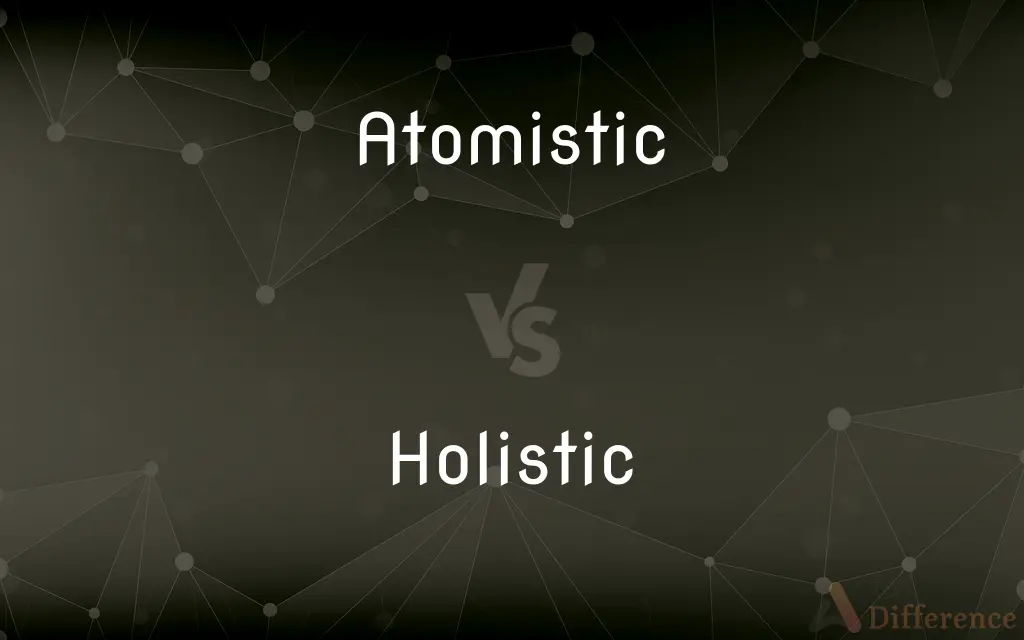Atomistic vs. Holistic — What's the Difference?
By Tayyaba Rehman & Urooj Arif — Updated on April 4, 2024
Atomistic refers to analysis or approach focusing on individual elements or parts, while holistic considers the whole system or entity, integrating all its aspects.

Difference Between Atomistic and Holistic
Table of Contents
ADVERTISEMENT
Key Differences
Atomistic perspectives or methodologies dissect a subject into its smallest parts to understand its properties, functions, or principles. This approach is common in sciences like physics or chemistry, where understanding individual elements leads to insights about the whole. Holistic approaches, in contrast, emphasize the interconnectedness and interdependence of all parts within a system, arguing that the whole is greater than the sum of its parts.
In an atomistic approach, the primary belief is that an entity's behavior can be fully understood by analyzing its individual components. For example, in studying social dynamics, an atomistic view might examine individual behaviors or roles. Conversely, a holistic approach to social dynamics would consider the social, economic, and environmental factors affecting the group as an integrated system.
Atomistic theories are often criticized for oversimplifying complex systems, failing to account for the interactions between parts that can lead to emergent properties. Holistic theories, while providing a comprehensive view, are sometimes criticized for being too broad or vague to allow for specific predictions or understandings of individual components' roles.
In practice, the atomistic and holistic approaches are not mutually exclusive and can be complementary. For instance, in healthcare, an atomistic approach might focus on treating a specific symptom or disease, whereas a holistic approach would consider the patient's overall physical, mental, and social well-being.
The choice between atomistic and holistic approaches depends on the research goals, the nature of the subject matter, and the specific questions being asked. While atomistic analysis provides detailed insights into the components of a system, a holistic approach offers a broader understanding of how those components interact within the whole.
ADVERTISEMENT
Comparison Chart
Definition
Focus on individual elements or parts.
Focus on the whole system, considering all aspects integrated.
Approach
Analyzes by breaking down into smallest components.
Analyzes by considering the system as an interconnected whole.
Common Fields
Physics, chemistry, certain social sciences.
Ecology, holistic medicine, some approaches to social sciences.
Criticism
May oversimplify complex interactions.
Can be too broad, lacking specificity.
Benefit
Detailed understanding of individual components.
Understanding of complex dynamics and emergent properties.
Application
Useful in studying material properties, individual behaviors.
Applied in understanding ecosystems, comprehensive health care.
Compare with Definitions
Atomistic
Focuses on breaking down systems into their smallest parts for analysis.
An atomistic study of the brain might focus on individual neurons.
Holistic
Considers the entirety of a system, integrating all its components.
Holistic medicine treats the patient's mental, physical, and emotional health.
Atomistic
Enables detailed examination of each component's properties.
In an atomistic approach, the chemical properties of each element are studied in isolation.
Holistic
Emphasizes that the whole is greater than the sum of its parts.
Holistic education integrates academic, social, and personal development.
Atomistic
May ignore the significance of interactions between components.
An atomistic view of ecology might overlook the importance of inter-species relationships.
Holistic
Recognizes complex interactions and emergent properties within systems.
Holistic approaches in urban planning consider the city's culture, economy, and environment.
Atomistic
Provides clarity and precision in understanding parts of a system.
Atomistic analysis in materials science can lead to the development of new compounds.
Holistic
Focuses on how parts of a system work together and influence one another.
A holistic approach to environmental conservation considers economic, social, and ecological factors.
Atomistic
Views systems as the sum of their individual parts.
Atomistic psychology examines the functions and roles of individual mental processes.
Holistic
Sometimes too general to provide detailed insights into individual components.
A holistic analysis of an economy may not capture the nuances of specific sectors.
Atomistic
Of or having to do with atoms or atomism.
Holistic
Of or relating to holism.
Atomistic
Consisting of many separate, often disparate elements
An atomistic culture.
Holistic
Emphasizing the importance of the whole and the interdependence of its parts.
Atomistic
Of or pertaining to atoms or to atomism.
Holistic
Concerned with wholes rather than analysis or separation into parts
Holistic medicine.
Holistic ecology.
Atomistic
Divided into separate elements; not holistic.
Holistic
Related to holism.
Atomistic
(economics) Of a market: divided such that no single actor can noticeably affect market-wide values such as the price; competitive.
Holistic
Relating to a study of the whole instead of a separation into parts.
Atomistic
Of or pertaining to atoms; relating to atomism.
It is the object of the mechanical atomistic philosophy to confound synthesis with synartesis.
Holistic
Emphasizing the organic or functional relation between parts and the whole
Atomistic
Divided into separate and often disparate elements; - the opposite of holistic.
Atomistic
Divided into separate and often disparate elements
Common Curiosities
What is an atomistic approach?
An atomistic approach focuses on dissecting a system into its smallest parts to understand it better.
What does holistic mean?
Holistic refers to an approach that considers the whole system, emphasizing the interconnections and interdependencies of all its parts.
What is a limitation of the holistic approach?
A limitation of the holistic approach is that it can sometimes be too broad, making it difficult to attain detailed insights into specific parts.
Can the atomistic approach apply to social sciences?
Yes, in social sciences, the atomistic approach can analyze individual behaviors or roles within a society or group.
What is a common criticism of atomistic theories?
A common criticism is that they can oversimplify complex systems by not accounting for the interactions between parts.
What is an example of emergent properties relevant to holistic approaches?
An example is the study of ecosystems, where the interactions between species can lead to new behaviors or patterns that wouldn't be predicted by looking at individual species alone.
What makes holistic education different?
Holistic education integrates various aspects of learning, including academic, social, and personal development, to foster well-rounded individuals.
Can atomistic and holistic approaches be combined?
Yes, combining atomistic and holistic approaches can provide a more comprehensive understanding of complex systems.
Why might someone choose an atomistic approach over a holistic one?
An atomistic approach might be chosen for its ability to provide detailed insights into the individual components of a system.
How do holistic and atomistic approaches influence research methods?
They influence research methods by determining whether the focus is on dissecting systems into their parts (atomistic) or understanding systems as wholes (holistic).
How do atomistic and holistic approaches differ in healthcare?
In healthcare, atomistic approaches focus on treating specific symptoms or diseases, while holistic approaches consider the overall well-being of the patient, including physical, mental, and social factors.
What fields commonly use holistic approaches?
Fields such as ecology, holistic medicine, and certain social sciences often use holistic approaches to understand the complex interactions within systems.
Why is the holistic approach important in environmental conservation?
It's important because it integrates ecological, social, and economic factors, leading to more sustainable conservation strategies.
Can the limitations of one approach be addressed by the other?
Yes, the detailed focus of atomistic approaches can complement the broad perspective of holistic approaches, and vice versa.
Share Your Discovery

Previous Comparison
Exponent vs. Proponent
Next Comparison
When vs. OnceAuthor Spotlight
Written by
Tayyaba RehmanTayyaba Rehman is a distinguished writer, currently serving as a primary contributor to askdifference.com. As a researcher in semantics and etymology, Tayyaba's passion for the complexity of languages and their distinctions has found a perfect home on the platform. Tayyaba delves into the intricacies of language, distinguishing between commonly confused words and phrases, thereby providing clarity for readers worldwide.
Co-written by
Urooj ArifUrooj is a skilled content writer at Ask Difference, known for her exceptional ability to simplify complex topics into engaging and informative content. With a passion for research and a flair for clear, concise writing, she consistently delivers articles that resonate with our diverse audience.















































